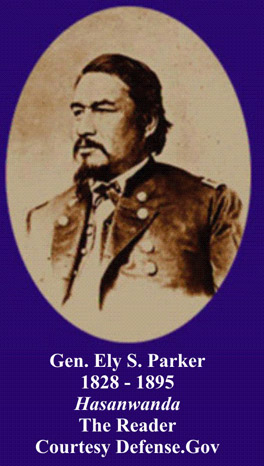Photographs (left to right): Olympic Peninsula Beach, Washington; Olympic Peninsula, , Washington;; Flowers; Olympic Peninsula, Washington
Wampum Belt Archive
Ely Parker Belt
(Donehogawah Belt)
![]()
Original (Clarke, 1931)
E-37434
Reproduction (R. D. Hamell) Dec. 12 2007
Original Size: |
Length: 37.75 inches. Width: 2.0 inches. Rows Wide: 7. |
Reproduction: |
Beaded Length: 48.0 inches. Width: 3.75 inches. Total length with fringe: 72.0 inches. |
Beads: |
Rows: 310 by 7 beads wide. Total: beads: 2,170 |
Materials: |
Warp: Leather. Weave: artificial sinew. |
Description:
General Ely S. Parker Belt also known as the Donehogawah Belt - Keeper of the Western Door. The five hexagons represent the Five Council Fires of the Iroquois Nations. The Three white rows of wampum on the ends signify the three warning that were always given to enemy nations to stop and cease hostile actions.
Quote Bardeau (2011)
At each end are three short white horizontal stripes. This belt was held by Donehogawah, the Doorkeeper of the Western Door. There would be its mate with the Mohawks at the Easter Door. When painted red, this belt represented war and complete extermination or absorption, depending on the decision may the nation(s).
General Ely S. Parker was the lifetime holder of the Seneca’s Keeper of the Western Door Wampum belt.

A History of Wilkes-Barre, Luzerne County, Pennsylvania. Vol. 1 by Oscar Jewell Harvey, Ernest Gray Smith
...(belt) contains 370 beads in seven rows. THere are three rows of five white beads each at the ends of the belts, and five open hexagons of white beads at equal intervals in the body of the belt. These hexagons represent the Five Nations. Some of the beads bear traces of red paint, which is evidence that the belt was once used as a "war belt," and might have been sent to or by the Five Nations. In the latter case the proposal of war was rejected, and the belt was returned. Mr Donaldson (previously mentioned) states that it is claimed that this belt bears "date about 1608, when Champlain joined the Algonkins against the Iroquois."
The belt was for many years prior to the death of Gen. Ely S. Parker ("Donehog aweh") - "the last watcher of the west door of the Confederacy of the Iroquois." From his heirs Mrs. Converse (previously mentioned) obtained it for the New York State Museum, and she described it as the "Five council-fires, or death belt, of the Five Iroquois Nations. It signified death or war against some other nation. It was always held by the keeper of the west door. When it was sent to the east door, the Hudson River, it was held in the council of war of each of the nations-Cayugas, Oneidas, Onondagas, Senecas and Mohawks, till return by them latter, which signal was that the was must begin at once."
Back with linen. 1956 acquired through Harriet M. Converse in 1899, who collected it from the descendants of Parker at Tonawanda earlier the year.
Reference:
Bardeau, Phyllis Eileen Wms. 2011. Definitive Seneca: It's In The Word.
Cardinal, Jare. editor. Seneca-Iroquois Museum Publisher, Salamanca, New York, 443pp.
Clarke, Noah T. 1931 New York State Museum Bulletin No. 288, Fig. 41.
see: https://archive.org/details/historyofwilkesba01harv for more information
 |
 |
 |
 |
 |
 |
 |
 |
|---|